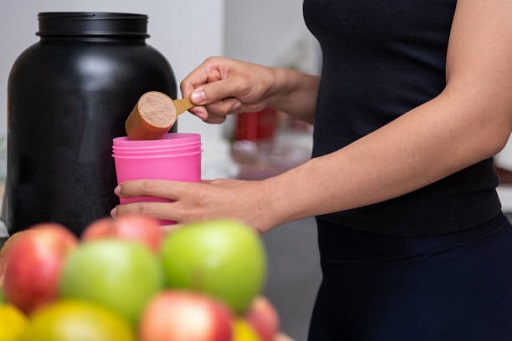If you’re trying to build bigger muscles, you need more protein in your body. Lifting weights causes tiny tears in your muscles, and then these muscles use the protein in your body to get bigger and stronger.
But it’s not always easy to add more protein into a diet. Usually, protein comes from meat, and meat is relatively expensive. Plus, the protein from the food will have other stuff you may not like, which adds to your calorie intake.
That’s why plenty of people take protein supplements as well. Usually, these are in powder from, and you can use the powder to make a protein shake.
But there are several different types of protein powder, and each has its own set of benefits and drawbacks:
Whey Protein
This is the most popular type, due to its notable advantages. It is a complete protein, which means it contains all the 9 essential amino acids needed for protein synthesis and muscle growth.
It also easily dissolves in water, and your body also quickly digests and absorbs the protein.
There are actually several types of whey protein:
- Whey protein concentrate. As the name implies, it packs a lot of protein, with about 70% to 80%. A lot of people prefer the taste of the concentrate over the other types of whey protein. However, this also contains lactose (the sugar in milk) and fat.
- Whey protein isolate. This actually contains more protein than the concentrate, with 90%. That’s because it doesn’t have as much lactose and fat.
- Whey protein hydrolysate. This is a predigested form of whey protein. It’s almost all protein (at 99%) and it really dissolves quickly in water. But it tastes bitter, even when it’s combined with other ingredients. Of course, nothing is stopping you to experiment to make the whey protein shake more delicious.
Casein Protein
The body absorbs the protein more slowly when it’s casein protein. So, it doesn’t work as well as a post-workout protein drink. It also doesn’t dissolve in water quickly.
But it’s great for overnight muscle recovery after your workout at the Goodlife Fitness gym, when your muscles continue to rebuild and require protein.
Egg-White Protein
This is the lactose-free version that you might want if you’re lactose-intolerant. It still contains 80% protein, along with all the 9 essential amino acids.
Collagen Protein
This is a more recent type of available protein powder, but it isn’t really as effective as whey, casein, or even egg-white protein when it comes to muscle growth. But it might help with skin elasticity and joint health.
Plant-Based Protein
The protein types mentioned so far come from dairy products (milk, eggs, and sometimes cheese). That might not be good enough for strict vegans, but there are still protein powders that come from plants.
- Soy. This is a very popular option for vegans, as soy protein powder also contains all the 9 essential amino acids. It also contains very little carbohydrates and fat. However, it doesn’t dissolve in water as quickly as whey protein does.
- Pea. Pea protein technically contains all the 9 essential amino acids. However, it doesn’t really contain a lot of methionine (one of the essential amino acids). This is why it is often paired with brown rice protein powder, which does contain adequate levels of methionine. Pea protein is also great for women because it contains iron, as women are more likely to suffer from iron deficiency due to menstruation.
- Rice. This is usually brown rice protein. It also contains all the 9 essential amino acids, though it doesn’t really contain a lot of leucine. This is another reason why it’s paired with pea protein, as pea does have lots of leucine.
- Hemp. It doesn’t have all the essential amino acids (only 7 of 9), but it contains omega-3 fatty acids that are good for your health. Also, it’s very easy to digest.
Hopefully, this guide can point you towards the right type of protein powder supplement to take.
